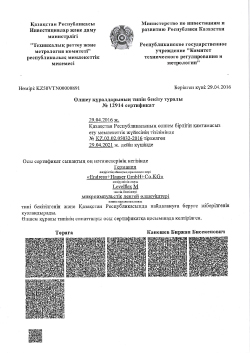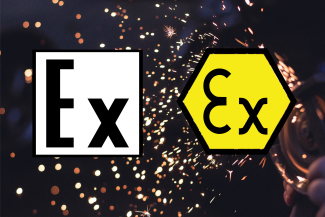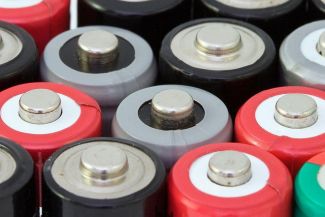
Kazakhstan, officially the Republic of Kazakhstan, has been a member of the Eurasian Economic Union (EAEU) since 2015. The EAEU is a significant association of five countries - Russia, Kyrgyzstan, Belarus, Armenia, and Kazakhstan - working together to create a dynamic economic zone. Within the EAEU, unified standards for quality and safety of products are established, which are anchored in technical regulations and GOST standards.
The EAC certification system was developed to facilitate the free movement of goods and services within this influential economic region and strengthen economic cooperation between member countries. Manufacturers and exporters wishing to distribute their products in EAEU member countries, including the emerging market of Kazakhstan, must ensure that their products meet the high minimum requirements of technical regulation.
As an integral part of the EAEU, Kazakhstan adheres to the common technical regulations and standards of the Union in conformity assessment, emphasizing the importance of this country in line with the advanced and innovative developments within the entire economic union.
Sanctions imposed by the EU and the US against Russia and Belarus, including trade embargoes, asset freezes, and restrictions on financial transactions, can directly affect the EAC certification process. This is because they create obstacles for both applicants and certification bodies.
We help to carry out the conformity assessment in Kazakhstan. We already have an office in Kazakhstan that is able to organize and carry out the EAC certification procedure, as well as take on the duties of an authorised representative.
Technical Regulations and Standards of the EAEU
The EAEU has established a comprehensive set of technical regulations and standards for various product categories such as machinery, electrical equipment, toys, food products, and textiles, etc. These regulations address aspects like safety, quality, environmental protection, and energy efficiency.
Some important technical regulations include:
- TR CU 004/2011 On the Safety of Low-Voltage Equipment
- TR CU 010/2011 – On the Safety of Machinery and Equipment
- TR СU 012/2011 On safety of the equipment for operation in explosive atmospheres
- TR CU 019/2011 On safety of personal protective equipment
- TR CU 020/2011 – Electromagnetic Compatibility of Technical Means
- TR CU 032/2013 – On the Safety of Pressure Equipment
- TR EAEU 037/2016 On restriction of the use of certain hazardous substances in electrical and electronic equipment
- TR EAEU 041/2017 On safety of chemicals
- TR EAEU 043/2017 On requirements for fire retardants and fire-extinguishing systems
Manufacturers and exporters should carefully review the relevant technical regulations for their products before applying for EAC certification to ensure that they meet the requirements.
EAC Certification Process in Kazakhstan
The EAC certification process in Kazakhstan involves several steps:
- Identify the applicable technical regulations: Determine the specific technical regulations and standards that apply to the product. One product may fall under several technical regulation as well as under national rules like pattern approval certification.
- Prepare the required documentation: Compile the necessary documents, including technical specifications, instruction manuals, and safety justifications. You may also need to provide test reports, risk assessments, and other supporting documents.
- Product testing and assessment: Depending on the product and the applicable technical regulations, you may need to have your product tested by an accredited laboratory and undergo a factory audit. The audit must be done by a 1c certification scheme.
- Submit the application: Submit the completed application and all required documents to the accredited certification body in Kazakhstan or another EAEU member country.
- Obtain the EAC certificate or declaration: If your product meets the necessary requirements, the certification body will issue an EAC certificate or declaration of conformity, allowing you to affix the EAC mark to your product and export it to Kazakhstan and other EAEU countries.
Differences between EAC Certificate and EAC Declaration
The EAC certificate and EAC declaration are two different ways of obtaining this conformity assessment. Here are the main differences between them:
- EAC Certificate is required for products that have a higher risk potential, such as household appliances, machinery, explosion proof equipment, and pressurized equipment. These products need to undergo a more rigorous conformity assessment process to ensure they meet the necessary safety and quality standards.
The certification process is carried out by an accredited certification body or a notified body. The manufacturer or importer must provide the necessary documentation, and the certification body is responsible for assessing the product's compliance. The certification process involveы product testing, factory audits, and regular inspection of the production process, depending on the product and technical regulation. The certification body carries out these activities to ensure the product's compliance. - EAC Declaration is applicable to products with a lower risk potential. The declaration process is usually less complex and time-consuming than the certification process.
The manufacturer or importer takes full responsibility for declaring the product's compliance with EAEU regulations. They need to prepare and submit the necessary documents, including test reports and technical files, to an accredited certification body or a notified body for registration purposes.
Depending on the declaration scheme, product testing may be part of the procedure. For examples, for scheme 3d, which implies the conduction of products tests in the accredited laboratory. Factory audits and regular inspections are generally not required for the declaration process.
While both EAC certificate and EAC declaration serve the purpose of confirming a product's compliance with EAEU regulations, the choice between the two depends on the product category, risk potential, and the specific technical regulations applicable to the product. The list of the products which fall under either certification or declaration is usually specified in the attachments to the regulations.
Required Technical Documents
To obtain an EAC Certificate or the EAC Declaration, the applicant must submit a comprehensive set of technical documents to demonstrate the product's compliance with the relevant technical regulations in the EAEU. The specific documentation requirements may vary depending on the product category and applicable regulations, but the following list outlines some of the most common documents required for EAC conformity document:
- Technical passport: A detailed technical description of the product, outlining its specifications, features, and intended use.
- Operating manual: A user manual or instruction guide that explains the proper installation, operation, maintenance, and safety precautions for the product.
- Safety justification: A document that provides a comprehensive analysis of potential risks and hazards associated with the product, along with the mitigation measures implemented to ensure safe operation.
- Test reports: Test reports from accredited laboratories, demonstrating that the product has undergone the necessary testing and meets the requirements set forth in the applicable technical regulations.
- Quality management system documentation: Evidence that the manufacturer has implemented and maintains an effective quality management system, such as ISO 9001 certification or other relevant standards.
- Technical drawings and schematics: Detailed technical drawings, diagrams, and schematics of the product, illustrating its design, components, and assembly.
- Material specifications and certificates: Information on the materials used in the manufacturing process, including material specifications and any applicable certificates of conformity.
- Manufacturing process description: A document outlining the manufacturing process, including information on production stages, equipment used, and quality control measures implemented.
- Contract with an authorized representative (if applicable): If the applicant is not the manufacturer, a contract with the manufacturer's authorized representative must be provided, confirming the applicant's authority to apply for EAC Certification on behalf of the manufacturer.
- Other documents: Depending on the specific product category and technical regulations, additional documents may be required, such as certificates of conformity for specific components, declarations of conformity for related standards, or other relevant documentation.
By providing a complete and accurate set of technical documents, applicants can streamline the EAC Certification process and avoid potential delays or complications arising from non-compliance with the EAEU technical regulations.
EAC Marking

The products listed as requiring an EAC certification under the technical regulation of the EAEU need to be marked with an EAC mark of the EAEU. This proves its conformity with all legal requirements of the EAEU.
The requirements to EAC marking and its conformity to the Technical Regulationa of the EAEU are listed in the decision of the board of the Customs Union Commission No. 711 from 15.07.2011.
The marking of products, which require an obligatory EAC certification under the technical regulation of the EAEU, is one condition for admission to the market. The placing on the market without appropriate marking is forbidden. Moreover, the EAC marking increases the trust of potential customers and the demand for the product.
Benefits of EAC Certification for Business in Kazakhstan
Obtaining EAC certification in Kazakhstanoffers several benefits to businesses, including:
- Market access: EAC certification enables businesses to access the entire EAEU market, which consists of more than 180 million consumers. This expanded market access can lead to increased sales and revenue potential for manufacturers and exporters.
- Competitive advantage: Companies with EAC-certified products can demonstrate their commitment to quality, safety, and regulatory compliance, providing them with a competitive edge over non-certified businesses in the EAEU market.
- Reduced trade barriers: EAC certification facilitates the free movement of goods within the EAEU, eliminating the need for multiple certifications or conformity assessments in each member country. This simplification reduces administrative burdens and costs for businesses.
- Enhanced reputation: EAC certification can enhance a company's reputation among consumers, partners, and regulators by demonstrating a commitment to the highest safety and quality standards.
- Compliance assurance: The EAC certification process helps businesses identify and address potential compliance issues, reducing the risk of regulatory fines, sanctions, or product recalls.
Challenges and Considerations
While EAC certification offers many benefits, businesses should also be aware of potential challenges and considerations:
- Complexity of regulations: The technical regulations and standards of the Customs Union can be complex and may require expert assistance to navigate. Companies should invest in understanding the specific requirements for their products and may need to engage external consultants or certification bodies for support.
- Costs: The EAC certification process can involve significant costs, including testing fees, certification fees, and potential expenses related to factory audits or expert consultations.
- Language barriers: The EAC certification process often requires documentation to be submitted in the official language of the member country where the certification is sought, which can be challenging for foreign businesses. Companies should be prepared to have their documentation translated and validated as needed.
- Changes in regulations: EAEU technical regulations and standards may change over time, requiring businesses to update their products and certifications accordingly. Companies should monitor regulatory updates to ensure ongoing compliance.
The EAC certification is crucial for companies looking to enter the Kazakhstan market or expand their presence in the EAEU.
With proper planning and support, EAC certification can provide businesses with expanded market access, competitive advantages, and an improved reputation in Kazakhstan and the entire EAEU.
Authorized representative
The Authorized Representative Person is an individual or legal entity registered in the member state of the EAEU and that represents the foreign manufacturer. This representative is responsible for facilitating the EAC certification process and ensuring compliance with the relevant technical regulations and standards.
The main tasks of the Authorized Representative Person include:
- Submitting the necessary documents and applications for obtaining the EAC certificate or declaration.
- Communicating with the certification body and competent authorities on behalf of the manufacturer or supplier.
- Ensuring the products meet the EAEU's technical regulations and standards.
- Providing information to customers and consumers regarding the certification process and conformity of the products.
- Maintaining records and documentation related to the EAC certification and product conformity.
- Informing the manufacturer or supplier about any changes in the EAEU regulations that may affect the product's compliance.
How do we help companies adopt various strategies for managing EAC certification in Kazakhstan?
Helping businesses adopt various strategies to navigate the EAC certification process is essential for their success in the EAEU market. During times of sanctions, we help businesses overcome the challenges associated with EAC certification and sanctions, ensuring their continued growth and success in the region.
- Evaluate alternative markets: Consider entering markets that are not directly affected by sanctions, where obtaining EAC certification may be less complicated. We propose to carry out conformity assessment in Kazakhstan. Our company already has an office in Kazakhstan, able to organize testing of product samples and conduct EAC-Certification, and to take on the duties of an authorized representative.
- Stay informed: Regularly monitor updates on sanctions and their potential impact on EAC certification processes. This will allow businesses to anticipate and respond to any changes that may affect their certification efforts. We help our clients stay up to date with the latest legislative developments through individual consultations, workshops, seminars or our newsletter.
- Seek guidance from experts: Engage with our experienced consultants who specialize in EAC certification and sanctions compliance. They can provide valuable advice on navigating the complex landscape and ensuring compliance with relevant regulations, in order to be able to carry out the EAC certification in a legally compliant and risk-free manner.
- Diversify supply chains: Reduce reliance on providers from sanctioned countries. For example, it is possible to transfer the responsibility for conducting inspection control to certification bodies located outside of Russia or Belarus and thus preserve the existing EAC certificates of conformity.
- Streamline the Certification Process: Assisting businesses in streamlining the EAC certification process can save time and resources. By identifying potential bottlenecks, simplifying documentation, and ensuring that all necessary requirements are met, companies can avoid delays and complications in obtaining certification. We offer businesses access to tools, templates, and checklists that simplify the EAC certification process and ensure that all requirements are met.
National technical regulations in Kazakhstan
In Kazakhstan, there are products for which no unified technical regulations of the EAEU have been drafted yet. The conformity of such products is ensured by the national technical regulations.
There are the following national technical regulations in Kazakhstan:
- Requirements for emissions into the environment from burning different types of fuel in boiler systems of thermal power plants - since December 14, 2007
- Requirements for the safety of paints, varnishes and solvents - since December 29, 2007
- Requirements for feed and feed additives - since March 18, 2008Requirements for the safety of synthetic detergents and household chemicals - since March 4, 2008
- Requirements for the safety of drugs and biological products in veterinary medicine - since April 23, 2008
- Pesticide Safety Requirements - since May 29, 2008
- Requirements for the safety of buildings and structures made of concrete and reinforced concrete - since December 22, 2008
- Requirements for the safety of wooden structures - since December 26, 2008
- General requirements for fire protection - since June 23, 2017
- Safety requirements for constructions made of other materials - since December 31, 2008
- Safety requirements for metal structures - since December 31, 2008
- Requirements for emissions to the environment in the production of ferro-alloys - since January 26, 2009
- Requirements for fertilizers - since May 28, 2010
- Nuclear and radiation protection of nuclear facilities for the purpose of research - since February 20, 2017
- Requirements for the safety of coal and its products during extraction, processing, storage and transport - since July 17, 2010
- Safety requirements for toxic and highly toxic substances - since November 19, 2010
- Requirements for the safety of bioethanol - since February 24, 2011
- Requirements for the safety of biodiesel - since February 10, 2011
Legal framework
Conformity assessment is regulated by law:
- Law of the Republic of Kazakhstan "On Technical Regulation" of November 9, 2004 No. 603-II;
- Technical regulation "On conformity assessment procedures" (Decree No. 90 of the Government of the Republic of Kazakhstan of February 4, 2008)
- other standards and regulations
Conformity mark

Products that have confirmed their conformity with the technical regulations of Kazakhstan must be marked with a conformity mark.
Products that have confirmed their quality and safety as part of voluntary certification are also marked with a conformity mark.
Metrological Approval Certification for Kazakhstan

In Kazakhstan, similar to Russia or Belarus, a metrological approval is required for all measuring instruments before their commissioning. This approval is also called Pattern Approval Certificate. The metrological certificate confirms that the certified measuring instruments meet the requirements of the technical regulation in Kazakhstan.
The objective is:
- Protection of consumers against unreliable measurement results
- Obtain reliable measurement results in basic research and scientific development
- Integration in the international system in order to guarantee unity of measurements
The metrological approval is regulated by the Law of the Republic of Kazakhstan of June 7, 2000 no. 53 II (with changes of November 26, 2019) “About ensuring unity of measurements".
In Kazakhstan the national meteorological center is responsible for the surveillance of measuring devices and metrological certification.
Mandatory metrological certification
The certificate is for those measuring instruments required that are used in a certain area defined by the state. Those areas are determined in article 23.
The state control holds for measurements whose result is used for:
- Work to protect the life and health of citizens
- Carrying out activities in the field of environmental protection, geology and hydrometeorology
- Conformity assessment procedures according to the legislation of the Republic of Kazakhstan on technical regulations
- Work to guarantee safety at work and in traffic
- Production of weapons, military equipment
- Calibration
Conditions for placing measuring instruments on the market:
Measuring instruments shall undergo a type approval before being placed on the market. The decision on type approval is taken by the notified body on the basis of the test results. As a result the approval certificate is issued.
For measuring equipment that is placed on the market as single copy, a metrological attestation is valid.
The decision on metrological attestation of measuring instruments is confirmed by a certificate.
Type approval and metrological attestation are carried out by the national metrological center.
After passing successfully the metrological tests, the equipment will enter in the state register and can be used in Kazakhstan.
Measuring instruments must be calibrated before being placed on the market, after repair and during operation. After calibration a verification mark is applied to the instrument.
If you have any questions about EAC certification in Kazakhstan, we are more than happy to provide you with advice and assistance.





